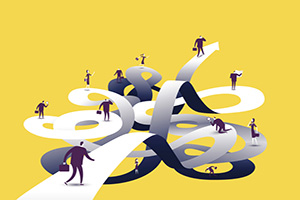
By Rhonda Kitch, AACRAO President
Creating and supporting an inclusive workplace is hopefully a goal for all of us. How can we take specific steps to support accessibility, not only with colleagues, but throughout our campus and professional communities? I believe it starts with intentionality.
I will acknowledge I am not an accessibility expert. I will admit to many bumbles, and I hope I can embrace my mindset as a “work in progress.” Confession: I am a parent of two Deaf/hard of hearing kids, who both rely on American Sign
Language (ASL) interpreters for their educational and personal journeys. In addition, our son uses bilateral cochlear implants, and our daughter uses bilateral hearing aids. Through their experiences, I have observed great approaches and potential
for improvement in our campus experiences for faculty, staff, and of course, students.
An inclusive accessibility approach recognizes and values physical accessibility, technological accessibility, and attitudinal awareness. Using the framework from 10 Ways to Develop Accessibility in the Workplace, I’ll share various resources, but note this is not an exhaustive list. I welcome any additional resources members would like to share.
Physical accessibility
- Universal design is the way an environment can be accessed, understood, and used by all individuals regardless of their age, size, ability, or disability. There are many benefits, as it is a human-centered approach. We all win with universal design. I remember the relief of seeing buttons to open doors when pushing a stroller or carrying heavy items. An ER doctor once commented on the decrease in broken bones from bicycle accidents after sidewalk ramps became the norm.
- Who on your campus is responsible for ADA compliance in the classroom? Registrars frequently chair or serve on classroom committees: how are remodeling projects or new buildings reviewed? Does access include considerations for parking, wheelchair/limited
mobility, inclusive sound, and braille signage?
- If you are speaking to more than a handful of people or in a room with challenging acoustics, use a microphone. If you remember nothing else from this article, when in doubt, use a mic.
- I cringe when I hear “I have a mom/dad/coach voice, I don’t need a mic” or if someone asks for a show of hands if a microphone is needed. A d/Deaf/hard of hearing person potentially won’t hear you even ask the question
or likely want to share their hearing loss status with the group.
- While I’d rather not use a microphone, I have learned it isn’t about me – it’s for the folks in the audience. If you need more convincing, check out this Chronicle of Higher Education article: A Note From Your Colleagues With Hearing Loss: Just Use a Microphone Already, by Jessie B. Ramey.
- Repeat any questions asked via a microphone or have a spare microphone to pass around the room.
Technology accessibility
- Conduct a technology risk assessment, reviewing websites and software; ensure compliance with recognized web accessibility standards.
- Collaborate with your IT department or review EDUCAUSE resources
- Where can captioning be incorporated into events and meetings?
- A pandemic win has been captioned video meetings, such as Zoom.
- Ensure any meeting recordings have captioning included.
- Be sure to review the captioning prior to publishing. Our kids have many awkward and funny stories about misconstrued captions.
- Learn the differences between live (or open) captioning and closed captioning and explore how to best incorporate them into meetings, events, online training, etc.
- Be mindful of colors and contrast in presentations; a colleague once shared that conferences can be a struggle if PowerPoints aren’t accessible for individuals with color vision deficiency.
- Make your social media hashtags accessible by capitalizing the first letter of each word in your hashtag. It’s friendlier for screen readers and people with dyslexia or other cognitive disabilities. It makes #RegistrarsAreCool easier to
read and avoids the brutal game of hashtag scrabble.
Attitudinal awareness
- Language is powerful. The National Center on Disability and Journalism offers inclusive language guidelines in its style guide.
- “d/Deaf” is an appropriate word in many situations, yet I cringe when I hear the phrase “fall on deaf ears.” Not all phrases may be evident, so I was grateful when a friend clued me in before my kids heard me say the
phrase.
- Subscribe to the weekly Better Allies newsletter, and check out the variety of resources on the site.
I often recall a humbling experience during college visits with our son. One of his stops was Gallaudet University in Washington, D.C. It is an officially bilingual institution with ASL and English used throughout the campus. While working through the
campus visit logistics, I had to request a voice interpreter, since I was not fluent enough in ASL to navigate our tour and various meetings with admission and faculty. Our Deaf son needed no accommodation. That brief experience significantly impacted
me as a parent and professional. It also solidified my resolve to do better, and to keep learning and listening. It’s a journey.
Resources